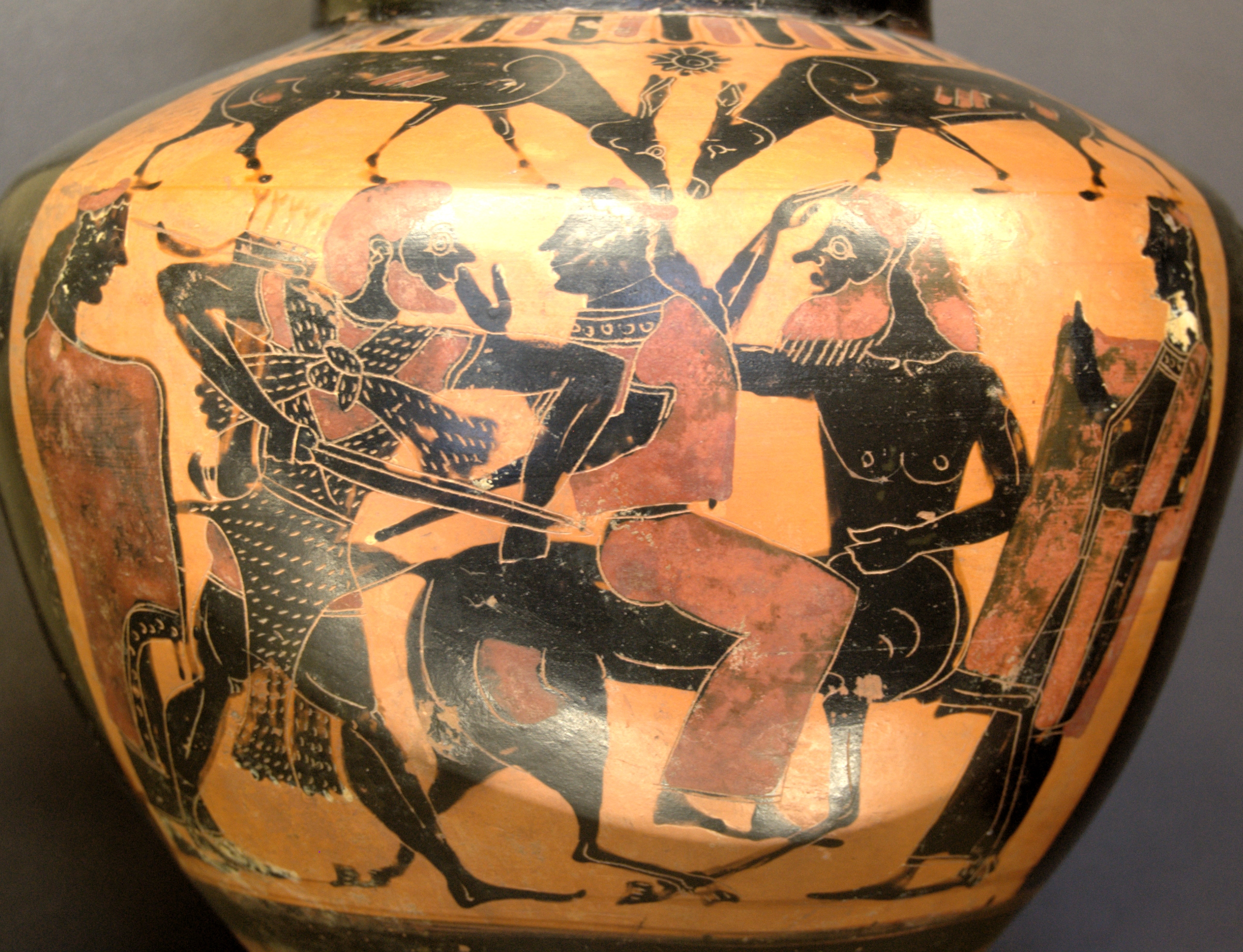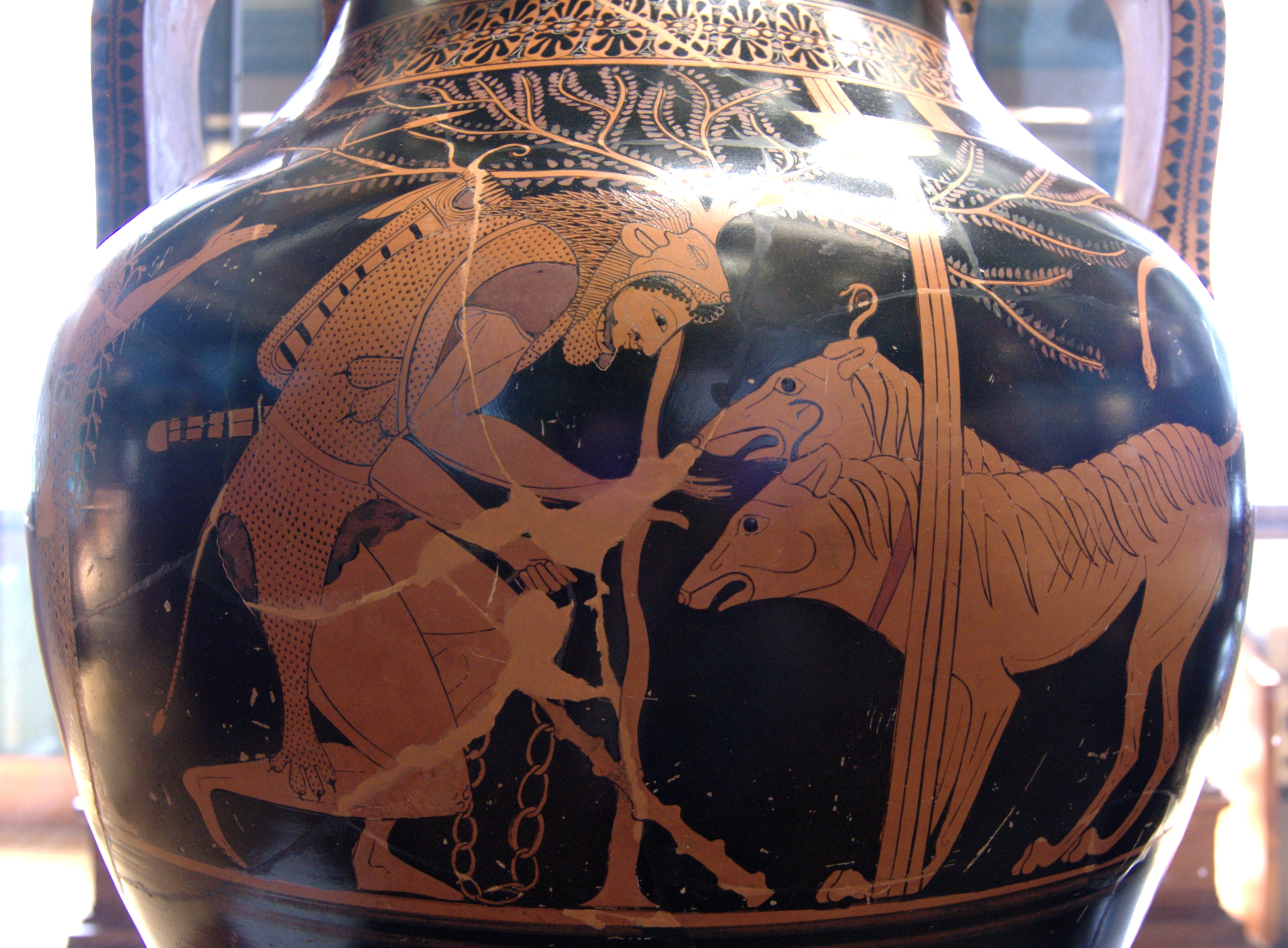|
Goliath And The Dragon
''Goliath and the Dragon'' ( it, La vendetta di Ercole, lit=Revenge of Hercules) is a 1960 international co-production sword-and-sandal filmKinnard, Roy; Crnkovich, Tony (2017). Italian Sword and Sandal Films, 1908-1990. McFarland. ISBN 978-1476662916. starring Mark Forest and Broderick Crawford. The name of the main character was changed from Hercules to Emilius (known in the film as Goliath) for release in North America by American International Pictures to sell it as a sequel to their earlier '' Goliath and the Barbarians'' (1959). American International Pictures had announced plans to create a "sequel" to '' Goliath and the Barbarians'' called ''Goliath and the Dragon'' based on a script by Lou Rusoff for star Debra Paget, but the project fell through, so they bought the rights to an already-made Italian film called '' Revenge of Hercules'' and retitled it ''Goliath and the Dragon''. American International Pictures changed the hero's name from "Hercules" to "Emilius" ("Goliath" ... [...More Info...] [...Related Items...] OR: [Wikipedia] [Google] [Baidu] |
Vittorio Cottafavi
Vittorio Cottafavi (30 January 1914 – 14 December 1998) was an Italian film director and screenwriter. He directed 70 films between 1943 and 1985. His film '' Il diavolo sulle colline'' was screened in the Un Certain Regard section at the 1985 Cannes Film Festival. Selected filmography * ' (1943) * ''The Gates of Heaven'' (1945) (actor) * ''The Sun Still Rises'' (1946) * '' The Unknown Man of San Marino'' (1946) * '' Fire Over the Sea'' (1947) * ''La grande strada'' (1948) * '' The Flame That Will Not Die'' (1949) * '' A Woman Has Killed'' (1952) * ''Milady and the Musketeers'' (1952) * '' Traviata '53'' (1953) * '' A Free Woman'' (1954) * '' It Takes Two to Sin in Love'' (1954) * ''Messalina'' (1960) * ''Hercules and the Conquest of Atlantis ''Hercules and the Conquest of Atlantis'' ( it, Ercole alla conquista di Atlantide, lit=Hercules at the Conquest of Atlantis) is a 1961 film directed by Vittorio Cottafavi and starring Reg Park in his film debut as Ercole/Hercule ... [...More Info...] [...Related Items...] OR: [Wikipedia] [Google] [Baidu] |
Debra Paget
Debra Paget (born Debralee Griffin; August 19, 1933) is an American actress and entertainer. She is perhaps best known for her performances in Cecil B. DeMille's epic ''The Ten Commandments'' (1956) and in Elvis Presley's film debut, '' Love Me Tender'' (1956), as well as for the risqué (for the time) snake dance scene in '' The Indian Tomb'' (1959). Early life Paget was born in Denver, Colorado, one of five children born to Margaret Allen (née Gibson), a former actress (one source says, "ex-burlesque queen"), and Frank Henry Griffin, a painter. The family moved from Denver to Los Angeles, California, in the 1930s to be close to the developing film industry. Paget was enrolled in the Hollywood Professional School when she was 11. Margaret was determined that Debra and her siblings would also make their careers in show business. Three of Paget's siblings, Marcia (Teala Loring), Leslie ( Lisa Gaye), and Frank (Ruell Shayne), entered show business. Paget had her first profession ... [...More Info...] [...Related Items...] OR: [Wikipedia] [Google] [Baidu] |
Nessus (mythology)
In Greek mythology, Nessus ( grc, Νέσσος, Nessos) was a famous centaur who was killed by Heracles, and whose poisoned blood in turn killed Heracles. He was the son of Centauros. He fought in the battle with the Lapiths and became a ferryman on the river Euenos. Mythology Nessus is known for his role in the story of the Tunic of Nessus. After carrying Deianeira, the wife of Heracles, across the river, he attempted to have intercourse with her. Heracles saw this from across the river and shot a Hydra-poisoned arrow into Nessus's breast. As he lay dying, as a final act of malice, Nessus told Deianeira that his blood would ensure that Heracles would be true to her forever, knowing the blood to be infected with the hydra's poison. Deianeira foolishly believed him. Later, when her trust began to wane because of Iole, she spread the centaur's blood on a robe and gave it to her husband. Heracles went to a gathering of heroes, where his passion got the better of him. Meanwhile, ... [...More Info...] [...Related Items...] OR: [Wikipedia] [Google] [Baidu] |
Centaur
A centaur ( ; grc, κένταυρος, kéntauros; ), or occasionally hippocentaur, is a creature from Greek mythology with the upper body of a human and the lower body and legs of a horse. Centaurs are thought of in many Greek myths as being as wild as untamed horses, and were said to have inhabited the region of Magnesia and Mount Pelion in Thessaly, the Foloi oak forest in Elis, and the Malean peninsula in southern Laconia. Centaurs are subsequently featured in Roman mythology, and were familiar figures in the medieval bestiary. They remain a staple of modern fantastic literature. Etymology The Greek word ''kentauros'' is generally regarded as being of obscure origin. The etymology from ''ken'' + ''tauros'', 'piercing bull', was a euhemerist suggestion in Palaephatus' rationalizing text on Greek mythology, ''On Incredible Tales'' (Περὶ ἀπίστων), which included mounted archers from a village called ''Nephele'' eliminating a herd of bulls that were the scourge ... [...More Info...] [...Related Items...] OR: [Wikipedia] [Google] [Baidu] |
Hyllus
In Greek mythology, Hyllus (; Ancient Greek: Ὕλλος) or Hyllas (Ὕλᾱς) was son of Heracles and Deianira, husband of Iole, nursed by Abia. Mythology Heracles, whom Zeus had originally intended to be ruler of Argos, Lacedaemon and Messenian Pylos, had been supplanted by the cunning of Hera, and his intended possessions had fallen into the hands of Eurystheus, king of Mycenae. After the death of Heracles, his children, after many wanderings, found refuge from Eurystheus at Athens. Eurystheus, on his demand for their surrender being refused, attacked Athens, but was defeated and slain. Hyllus and his brothers invaded Peloponnesus, but after a year's stay were forced by a pestilence to quit. They withdrew to Thessaly, where Aegimius, the mythical ancestor of the Dorians, whom Heracles had assisted in war against the Lapidae, adopted Hyllus and made over to him a third part of his territory. After the death of Aegimius, his two sons, Pamphylus and Dymas, voluntarily sub ... [...More Info...] [...Related Items...] OR: [Wikipedia] [Google] [Baidu] |
Deianira
Deianira, Deïanira, or Deianeira (; Ancient Greek: Δηϊάνειρα, ''Dēiáneira'', or , ''Dēáneira'', ), also known as Dejanira, is a Calydonian princess in Greek mythology whose name translates as "man-destroyer" or "destroyer of her husband". She was the wife of Heracles and, in late Classical accounts, his unwitting murderer, killing him with the poisoned Shirt of Nessus. She is the main character in Sophocles' play ''Women of Trachis''. Family Deianira was the daughter of Althaea and her husband Oeneus (whose name means "wine-man"), the king of Calydon (after the wine-god gave the king the vine to cultivate), and the half-sister of Meleager. Her other siblings were Toxeus, Clymenus, Periphas, Agelaus (or Ageleus), Thyreus (or Phereus or Pheres), Gorge, Eurymede and Melanippe. In some accounts, Deianira was the daughter of King Dexamenus of Olenus and thus, sister to Eurypylus, Theronice and Theraephone. Others called this daughter of Dexamenus as Mnesimach ... [...More Info...] [...Related Items...] OR: [Wikipedia] [Google] [Baidu] |
Cerberus
In Greek mythology, Cerberus (; grc-gre, Κέρβερος ''Kérberos'' ), often referred to as the hound of Hades, is a multi-headed dog that guards the gates of the Underworld to prevent the dead from leaving. He was the offspring of the monsters Echidna and Typhon, and was usually described as having three heads, a serpent for a tail, and snakes protruding from multiple parts of his body. Cerberus is primarily known for his capture by Heracles, the last of Heracles' twelve labours. Descriptions Descriptions of Cerberus vary, including the number of his heads. Cerberus was usually three-headed, though not always. Cerberus had several multi-headed relatives. His father was the multi snake-headed Typhon, and Cerberus was the brother of three other multi-headed monsters, the multi-snake-headed Lernaean Hydra; Orthrus, the two-headed dog who guarded the Cattle of Geryon; and the Chimera, who had three heads: that of a lion, a goat, and a snake. And, like these close ... [...More Info...] [...Related Items...] OR: [Wikipedia] [Google] [Baidu] |
Ancient Thebes (Boeotia)
Thebes (; ell, Θήβα, ''Thíva'' ; grc, Θῆβαι, ''Thêbai'' .) is a city in Boeotia, Central Greece. It played an important role in Greek myths, as the site of the stories of Cadmus, Oedipus, Dionysus, Heracles and others. Archaeological excavations in and around Thebes have revealed a Mycenaean settlement and clay tablets written in the Linear B script, indicating the importance of the site in the Bronze Age. Thebes was the largest city of the ancient region of Boeotia and was the leader of the Boeotian confederacy. It was a major rival of ancient Athens, and sided with the Persians during the 480 BC invasion under Xerxes I. Theban forces under the command of Epaminondas ended Spartan hegemony at the Battle of Leuctra in 371 BC, with the Sacred Band of Thebes, an elite military unit of male lovers celebrated as instrumental there. Macedonia would rise in power at the Battle of Chaeronea in 338 BC, bringing decisive victory to Philip II over an alliance of Thebe ... [...More Info...] [...Related Items...] OR: [Wikipedia] [Google] [Baidu] |
Eurystheus
In Greek mythology, Eurystheus (; grc-gre, Εὐρυσθεύς, , broad strength, ) was king of Tiryns, one of three Mycenaean strongholds in the Argolid, although other authors including Homer and Euripides cast him as ruler of Argos. Family Eurystheus was the son of King Sthenelus and Nicippe (also called Antibia or Archippe), and he was a grandson of the hero Perseus.Apollodorus, 2.4.5 His sisters were Alcyone and Medusa, and he married Antimache, daughter of Amphidamas of Arcadia. Their children were Admete, Alexander, Iphimedon, Eurybius, Mentor, Perimedes and Eurypylus.Athenaeus, ''Deipnosophistae'4.158(p. 219) Mythology Labours of Heracles In the contest of wills between Hera and Zeus over whose candidate would be hero, fated to defeat the remaining creatures representing an old order and bring about the reign of the Twelve Olympians, Eurystheus was Hera's candidate and Heracles—though his name implies that at one archaic stage of myth-making he had carrie ... [...More Info...] [...Related Items...] OR: [Wikipedia] [Google] [Baidu] |
Cerberus
In Greek mythology, Cerberus (; grc-gre, Κέρβερος ''Kérberos'' ), often referred to as the hound of Hades, is a multi-headed dog that guards the gates of the Underworld to prevent the dead from leaving. He was the offspring of the monsters Echidna and Typhon, and was usually described as having three heads, a serpent for a tail, and snakes protruding from multiple parts of his body. Cerberus is primarily known for his capture by Heracles, the last of Heracles' twelve labours. Descriptions Descriptions of Cerberus vary, including the number of his heads. Cerberus was usually three-headed, though not always. Cerberus had several multi-headed relatives. His father was the multi snake-headed Typhon, and Cerberus was the brother of three other multi-headed monsters, the multi-snake-headed Lernaean Hydra; Orthrus, the two-headed dog who guarded the Cattle of Geryon; and the Chimera, who had three heads: that of a lion, a goat, and a snake. And, like these close relatives ... [...More Info...] [...Related Items...] OR: [Wikipedia] [Google] [Baidu] |
Monster
A monster is a type of fictional creature found in horror, fantasy, science fiction, folklore, mythology and religion. Monsters are very often depicted as dangerous and aggressive with a strange, grotesque appearance that causes terror and fear. Monsters usually resemble bizarre, deformed, otherworldly and/or mutated animals or entirely unique creatures of varying sizes, but may also take a human form, such as mutants, ghosts and spirits, zombies or cannibals, among other things. They may or may not have supernatural powers, but are usually capable of killing or causing some form of destruction, threatening the social or moral order of the human world in the process. Animal monsters are outside the moral order, but sometimes have their origin in some human violation of the moral law (e.g. in the Greek myth, Minos does not sacrifice to Poseidon the white bull which the god sent him, so as punishment Poseidon makes Minos' wife, Pasiphaë, fall in love with the bull. She copulat ... [...More Info...] [...Related Items...] OR: [Wikipedia] [Google] [Baidu] |
Dragon
A dragon is a reptilian legendary creature that appears in the folklore of many cultures worldwide. Beliefs about dragons vary considerably through regions, but dragons in western cultures since the High Middle Ages have often been depicted as winged, horned, and capable of breathing fire. Dragons in eastern cultures are usually depicted as wingless, four-legged, serpentine creatures with above-average intelligence. Commonalities between dragons' traits are often a hybridization of feline, reptilian and avian features. Scholars believe huge extinct or migrating crocodiles bear the closest resemblance, especially when encountered in forested or swampy areas, and are most likely the template of modern Oriental dragon imagery. Etymology The word ''dragon'' entered the English language in the early 13th century from Old French ''dragon'', which in turn comes from la, draconem (nominative ) meaning "huge serpent, dragon", from Ancient Greek , (genitive , ) "serpent, giant s ... [...More Info...] [...Related Items...] OR: [Wikipedia] [Google] [Baidu] |









